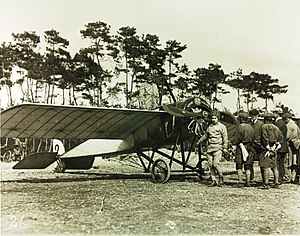Morane-Saulnier G
| Type G | |
|---|---|

| |
| Role | Sport aircraft |
| Manufacturer | Morane-Saulnier |
| First flight | 1912 |
The Morane-Saulnier G was a two seat sports and racing monoplane produced in France before the First World War.[1][2] It was a development of the racing monoplanes designed by Léon Morane and Raymond Saulnier after leaving Borel and, like its predecessors, was a wire-braced, shoulder-wing monoplane.[2] Construction was of fabric-covered wood throughout, except for the undercarriage struts which were of steel tube.[3]
The type was a sporting success. In April 1913, Roland Garros took second place in the inaugural Schneider Cup in a floatplane version,[4] finishing with a time of 40 minutes 40 seconds.[5] On 26 June, Claude Grahame-White flew another float-equipped example from Paris to London via Le Havre, Boulogne-sur-Mer, and Dover,[6] covering some 500 km (310 mi) that day.[7] Between 21 and 28 September the same year, two float-equipped Type Gs competed at the seaplane meeting at San Sebastián, with Lord Carbery winning the short take-off prize on one, and Edmond Audemars winning the maneuverability prize on the other.[8] The following week, Carbery flew his Type G in the Italian Waterplane Contest from Lake Como to Pavia and back, along with two other Type Gs in the field of fifteen competitors, these flown by Garros and Morane.[9][10] Garros not only won the Grand Prize in the "general class", but also the prizes for best speed (127.7 km/h, 79.8 mph) and greatest altitude (2,100 m, 6,000 ft).[9]
In 1914, Russian manufacturer Duks arranged to build the type under licence at their Moscow factory for the Russian Army,[9] and the same year, the Turkish military ordered 40 examples.[9] Before these could be delivered, however, war broke out, and the aircraft were impressed into the French Army.[9] To these, the Army soon added an order of 94 aircraft, and the British Royal Flying Corps also acquired a number, these latter machines purchased from Grahame-White, who was manufacturing the type in the UK under licence.[2] At the outbreak of war, the type's military value was found to be wanting, and the French machines were quickly relegated to training duties.[2]
Despite this, a dedicated single-seat fighter version was built in 1915, armed with an 8 mm Hotchkiss machine gun that fired through the propeller arc, the propeller blades being protected by deflector plates.[11] Only one or two prototypes were built, and the type never entered service.[12]
Some Type Gs were modified by Morane-Saulnier to have their wings mounted above the fuselage, parasol-fashion, rather than at the fuselage sides. This arrangement was found to offer far better visibility for the pilot, and formed the basis for the Morane-Saulnier L.[2]
A Type G is preserved at the Museo del Aire (Madrid) (Museo del Aire de Cuatrovientos).
Variants
- Type GA
- version with 40 kW (60 hp) Le Rhône engine
- Type GB
- version with 60 kW (80 hp) Gnome engine
- Type WB
- version for export to Russia with glazed forward fuselage
- Thulin B
- Licence-built by AB Thulinverken in Sweden
- Grahame-White Type XIV
- License built by Claude Grahame-White in the United Kingdom
Operators
- Cuban Air Force - One aircraft.
- Aéronautique Militaire (94 ordered, plus 40 impounded from Turkish order)
- French Navy
- Soviet Air Force - Taken over from the Imperial Russian Air Force.
- Ottoman Air Force - 40 ordered, but never delivered.
Specifications (GB)
Data from Jane's Fighting Aircraft of World War I, 116
General characteristics
- Crew: One pilot
- Capacity: 1 passenger
Performance
Notes
- ^ Taylor 1989, 648
- ^ a b c d e "The Illustrated Encyclopedia of Aircraft", 2539
- ^ "The Latest Morane-Saulnier Monoplane", 564
- ^ Hartmann 2001, 10. This machine is often mis-reported as a Morane-Saulnier H
- ^ "The Monaco Meeting", 450
- ^ "Mr Grahame-Wnite's Seine—Thames Trip"
- ^ Hartmann 2001, 10
- ^ Hartmann 2001, 11
- ^ a b c d e Hartmann 2001, 12
- ^ "Italian Waterplane Contest", 1129
- ^ "Morane-Saulnier type G"
- ^ Green and Swanborough 1994
References
- Green, William; Gordon Swanborough (1994). The Complete Book of Fighters. Godalming, UK: Colour Library Direct. ISBN 0-86288-220-6.
- Hartmann, Gérard (2001). "L'incroyable Morane-Saulnier hydro" (PDF). La Coupe Schneider et hydravions anciens/Dossiers historiques hydravions et moteurs. Retrieved 2008-11-07.
- The Illustrated Encyclopedia of Aircraft. London: Aerospace Publishing.
- "Italian Waterplane Contest". Flight: 1129. 11 October 1913. Retrieved 2008-11-10.
- Jane's Fighting Aircraft of World War I. London: Studio Editions. 2001. ISBN 0-517-03376-3.
- "The Latest Morane-Saulnier Monoplane". Flight: 561–64. 24 May 1913. Retrieved 2008-11-07.
- "The Monaco Meeting". Flight: 450. 19 April 1913. Retrieved 2008-11-07.
- "Mr Grahame-Wnite's Seine—Thames Trip". Flight: 749. 5 July 1913. Retrieved 2008-11-07.
- "Morane-Saulnier type G". EADS website. Retrieved 2008-11-07.
- Taylor, Michael J. H. (1989). Jane's Encyclopedia of Aviation. London: Studio Editions. ISBN 0-7106-0710-5.
